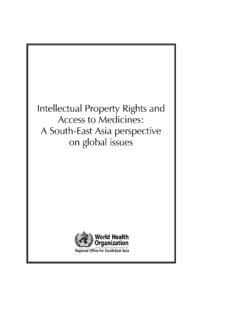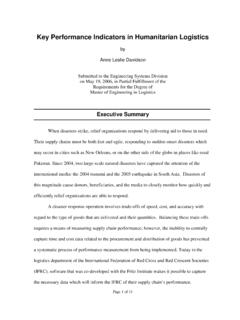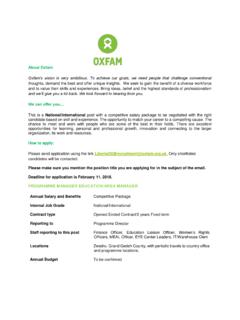Transcription of Benchmarks, Standards and Indicators for …
1 Draft VI. July 2007. Benchmarks, Standards and Indicators for emergency Preparedness and Response emergency and humanitarian Action World Health Organization Regional Office for South-East Asia New Delhi, India Page 1. Draft VI. July 2007. Introduction Benchmarking is a strategic process often used by businesses to evaluate and measure performance in relation to best practices of their sector. WHO. and its partners decided to apply the process of setting benchmarks as a novel approach for increasing performance in emergency preparedness and response. At a regional meeting in Bangkok in November 2005, twelve benchmarks on emergency preparedness and response were formulated by all 11 SEAR member countries.
2 The Benchmarks are broad in nature as they reflect the consensus of all 11 countries on the desired performance for improving emergency preparedness and response. The twelve benchmarks fall into the categories of 1) human resource development, training and education; 2) planning; 3) legislation and policy; 4) funding; 5) vulnerability assessment; 6) information systems; 7) surveillance; 8) absorbing and buffering capacities and responses; 9) patient care; and 10) coordination. Because the Benchmarks were formulated by a group comprising of participants from several sectors including health, home affairs, foreign affairs and education, they have a broad approach and integrate multi-sectoral concerns at community, sub-national and national levels.
3 This means that once all Benchmarks are achieved, the level of preparedness of the country would be extremely high with inter-sectoral linkages and wide participation by all stakeholders. However, to achieve these is a long-term process, and the guiding principle is that not all countries will devote equal attention to all 12 benchmarks simultaneously. Rather, each country will have to prioritize its interventions based on specific hazard scenarios, areas with high vulnerability and the existing capacity of the country. The framework provided by the Benchmarks is a strong tool for planning emergency preparedness programmes and activities. In order to facilitate monitoring and evaluation of progress against the Benchmarks and analysis of existing gaps, it is necessary to break down the individual benchmark into its corresponding Standards and Indicators that spell out the best practices implicitly understood in the benchmarks.
4 The framework as outlined in this document consists of the benchmark and its corresponding Standards . Each benchmark has two to three Standards and each standard has between one to four health sector Indicators against which monitoring can take place. The health sector Indicators all refer to health related issues that various partners ranging from MOH, district health authorities, hospitals, UN agencies, NGOs and community partners have a mandate to ensure. The Indicators are as specific as possible to make them measurable, but as they have to cater to 11 different countries, they remain somewhat generic. It is up to each country to formulate the precise and measurable indicator that applies to its situation.
5 For each standard, a set of non-health sector, or other sectors Indicators ', has been included. The other sectors Indicators refer to essential preparedness issues that are not within the means of the health sector to achieve but that nonetheless will have a crucial impact on the overall preparedness levels of the country. Although their implementation might not be the mandate of the health sector, they are important to consider when planning and evaluating the health sector emergency preparedness activities. Finally, the framework also includes a checklist. The checklist consists of pertinent questions for each standard that can help guide analysis of the existing situation and thus facilitate the establishment of the baseline that progress will be evaluated against.
6 Page 2. Draft VI. July 2007. For the purpose of this document the following definitions are used: benchmark Benchmarking denotes a strategic process for organizations to evaluate and measure performance in relation to best practices of their sector. Setting benchmarks facilitates the development of plans of how increase various aspects of performance to adopt the best practices. The 12 benchmarks are broad in nature as they reflect the consensus of all 11 countries of the SEA region on the desired performance for improving emergency preparedness and response. Standard Standard denotes a technical reference level of quality or attainment. The Standards are qualitative and universal in nature and are applicable in any operating environment as they specify the minimum level to be attained.
7 The Standards related to each benchmark are derived from the benchmark itself and further defines the technical quality of all components of the benchmark . indicator indicator denotes tools of measurements to the Standards . They provide a way to measure and determine progress in achieving the Standards . The Indicators are both qualitative and quantitative and are universal in nature to reflect the fact they are regional Indicators . A corresponding set of specific Indicators should be developed at the country level to monitor the country-level progress towards the Standards and benchmarks. Definitions are based on: The Sphere Project, humanitarian Charter and Minimum Standards in Disaster Response, 2004 edition HAC TYP project, Framework: a Three-year Programme to improve the performance of the World Health Organization, HAC TYP project, Annexes: a Three-year Programme to improve the performance of the World Health Organization Journal of Pre-hospital and Disaster Medicine, Health Aspects of Disaster Preparedness and Response Report from a Regional Meeting of Countries of South East Asia Bangkok, Thailand, 21 23 November 2005, vol.
8 21, Supplement 3. Page 3. Draft VI. July 2007. Benchmarks, Standards and Indicators No benchmark Standards Health Sector Indicators Other sectors Indicators Question / Checklist 1 Legal framework A legal framework Health Sector specific policies and Comprehensive Is there an exclusive act/legal provision and functioning for preparedness regulations to implement provisions constitutional law/Act relating to emergency preparedness, coordination and responses is in of laws/acts (as above) are covering emergency response and mitigation linked to the mechanisms and place with sector developed and instituted preparedness, response, constitution in the country?
9 An organizational specific policies / recovery and mitigation National health policy / plans structure in place provisions is enacted includes EPR. for health EPR at all Review of existing levels involving all Laws/acts for stakeholders;. emergencies is conducted as per provision of national constitution Coordination Health sector is represented in Formal EPR Is there a similar coordination mechanisms formal EPR coordination coordination mechanism at national, sub-national involving mechanisms mechanisms identifying (provincial); district; sub-district and government, UN, all key stakeholders is in community level that has also been Specific health sector coordination civil society and place at national and established in line with existing mechanism is developed and private stakeholders sub-national levels legislation?
10 Institutionalized at all levels are in place and Has the health sector coordination and functioning at Activities for health sector EPR. response mechanism been established national, provincial/ coordination are taking place as at the different levels of the health regional and district specified by an established delivery system in the country including level mechanism ( meetings per involvement of health services of the month; report submission). armed-forces and NGOs? Organizational Human and financial resources for Roles, responsibilities, Has the administrative framework for structure that include health sector EPR are identified and and lines of authority EPR been identified in the country ( defined roles for matched to the mechanisms in are clearly defined and nodal and other support ministries at the preparing for and place at national and sub national supported by national level)?








